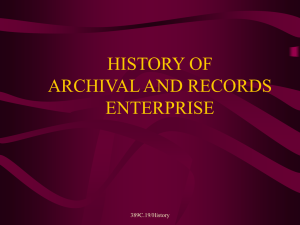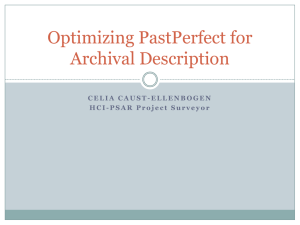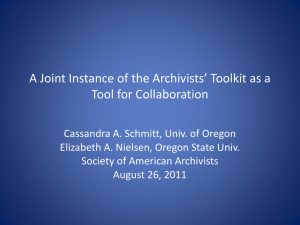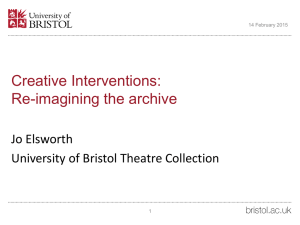Collecting, Organizing, and Preserving Our History
advertisement
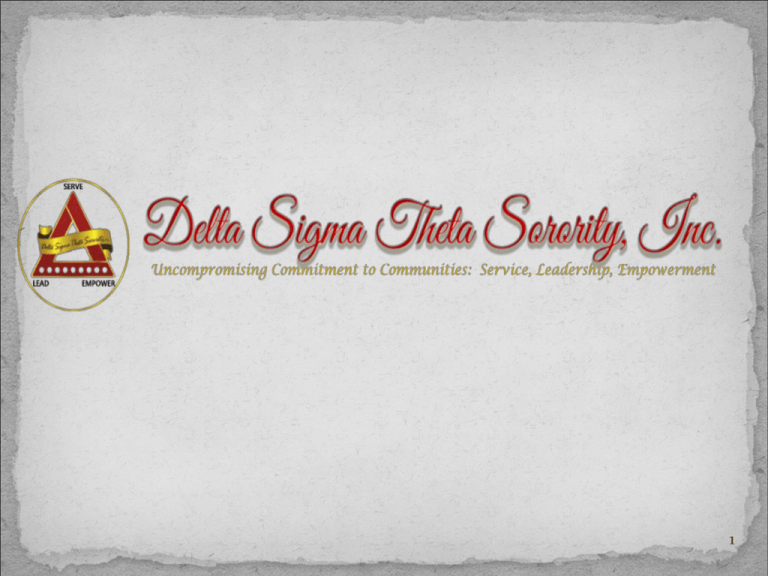
1 Collecting, Organizing, and Preserving Our History Presented by the National Heritage and Archives Committee Soror Lois Gilder, Co- Chair Soror Lula Morehouse, Co Chair Soror Bertha M. Roddey, 20th National President and Honorary Co-Chair 3 Paralee Day - Midwest Joy Kinard - Eastern Patricia McGee - Midwest Regina Scott - Midwest Jacquilin Reynolds - Southern Wilhelmina Goff - Eastern Gloria Fuller - Eastern Jessie Nave Carpenter - Central Barnelle Herring - Eastern Stephaney Crawford - South Atlantic Schwanzetta Aikens - South Atlantic Christine Miller Betts - Southern Luvenia Butler - Southern Luvenia Lane – Farwest Ella Goode Johnson - Southwest Verna Lambert - Southern C Gloria Akers - Eastern Amber Williams – Archivist - Eastern Jacqueline Stemmons - Southwest Garlenda McNair – Liaison - Eastern 4 It is the duty of the Heritage and Archives Committee to provide and organized method of research, analysis, and categorization of the Sorority’s historical data. 5 Welcome and Introductions Workshop Objectives Role of Heritage & Archives Committee Building Our History Collecting Our History Preserving Our History Chapter Template /Inventory Form Heritage Moments Resources Questions & Answers Thank you and NHA contact Information 6 I am Soror:________________ Member of National Heritage and Archives Come Join Us! 7 Does your Chapter have a Historian or a Heritage and Archives Committee? Who has access to your Chapter’s Archives? Where are your Chapter’s Archives kept? Describe the record keeping process for your chapter. If you answered no, The Time Is Now! Collect Organize Preserve 8 Assist participants in developing a better understanding of the necessity of archiving and maintaining local chapter records. Provide basic preservation tips and techniques Introduce participants to the chapter history template and inventory form Introduce participants to creative means of sharing their stories during the Delta Heritage Celebration Introduce Heritage Moments to chapters. 9 Establish archival guidelines and procedures for maintaining and disposing of chapter records • • • Document chapter history Document chapter programs and activities Gather, organize, store and preserve records, documents, photos, etc. 10 Provide guidelines for chapters to determine what to archive, length of time, how to protect and preserve Materials that document sorority business Suggest preservation formats Recommend archival materials and resources Implement special projects to display and celebrate chapter histories 11 Organize a Committee • • Chapter President Appoint a Committee Chair Alumnae Chapters: • Members can be a mix of those who are interested in history, Delta Dears and Past Presidents • Sorors into technology can help with technology, librarians can help cataloging / categorizing • Different tasks and talents are needed from sorors who have 1 year in Delta to those with over 50 years. Invite sorors to participate and you will get more support • Collegiate Chapters: • Members can be those who are interested in history or History majors • Sorors can connect with local alumnae chapter sorors who were initiated in their collegiate chapter • Different tasks and talents are needed from sorors. It is a great bonding activity for the entire chapter 12 Start Where Your Chapter is now • • • Items already gathered ( i.e. file cabinets, boxes, scrapbooks) If possible, create a location where all items can be stored Starting from scratch is also a great beginning Organize and Appraise Existing items • • Determine categories of things already gathered Decide what to keep or weed 13 Create a Collection Development Policy • • • • Define what you will typically collect and keep. Look at the kinds of things you have kept. Be flexible as new concepts arrive. However, you can not and should not collect everything What is suggested by the region or Grand Chapter? Additionally, what is important to your chapter and servicing area? Educate chapter members on policies and needs Review your chapter polices and procedures for a heritage and archives committee Examples of Materials to Collect • • • • • • • • Chapter Charter Chapter Written History Bios and pictures of charter members and Past Presidents Newsletters / Brochures Programs (May Week, Founders’ Day, Jabberwock) News Articles Five Point Thrust Service Projects (programs, photos) Newspaper articles, clippings 14 Use Technology • • • • Computers, word processing programs Create database / index of items Create searchable database to locate items Store Data (CD burning of scanned items, photo collections) Develop a Budget • • • Storage supplies Archival materials Technological needs (i.e. CDS, scanner, laptop) 15 16 17 Why Archive our History? Provide evidence of chapter history, contributions, and accomplishments. Document the policies, programs, and activities. Provide historical perspectives for future generations of Deltas. Add to the body of knowledge documenting our shared regional and national history and experiences. 18 Preservation Encompasses all the steps and activities needed to ensure that the holdings of a library or archive remain in the best possible condition for as long as possible”* Preservation practices can and should be performed by all interested parties. “ Conservation “Emphasis on the physical treatment of specific items or collections”* Conservation should usually be undertaken only by a trained conservator. *Balloffet, Nelly and Jenny Hille. Preservation and Conservation for Libraries and Archives. Chicago: American Library Association, 2005. Print. 19 A hard truth about archiving: not everything can or SHOULD be saved. Create collection priorities for your organization. Whenever possible, maintain the original order of the materials. If materials are in no discernible order, you may impose a simple, logical scheme of your own devising. It is usually advisable to arrange materials by date, subject matter, or material type, or a combination thereof. Make sure any materials you use are of archival quality, i.e. acid-free, lignin-free, pH neutral Create a “finding aid” for your collection. Even a very simple document listing what types of materials you have could prove useful for both research and security purposes. Do not use any staples or paper clips unless they are stainless steel. In fact, any non-stainless fasteners should be removed, as they could rust and cause damage to the materials. Do not mark on documents with an ink pen. If notes MUST be made, do so lightly using a pencil. 20 The single most impactful thing you can do to preserve your historical materials is to store them in a stable environment. Make sure your storage area is dry, cool, and relatively dark. Temperature -- around 70 degrees Fahrenheit Relative Humidity (RH) – under 55% Keep materials away from plumbing, heat sources, windows, outer building walls, and the floor. UV light will damage paper documents, photographs and textiles, so make sure your items are exposed to as little light as possible. Dust and vacuum your storage area on a regular basis, but keep liquid cleaners away from your materials! Be aware of the condition of your storage area and the entire building. Do a visual inspection on a regular basis. Also, note any strange smells, which may be a sign of mildew. 21 Do not house photographs in scrapbooks with acidic plastic sleeves or “magnetic” pages. Photographs should be stored either in photograph envelopes made of acid-free paper or in archival (non-PVC) plastic sleeves. Photographic storage materials will sometimes be described as “P.A.T. compliant” or “Passes P.A.T.” (Photographic Activity Test), which assures their archival quality. If you choose to store photographs in scrapbooks, make certain the pages are of acid-free paper and that the photographs are secured with archival corners. Do NOT glue or tape images to pages. 22 Make sure that your photographs are properly labeled, including date, location, event, and names of individuals. (This information is often referred to as “metadata.”) If labeling photographs directly, use a specialty felt-tipped marker or soft-leaded photo pencil. Another alternative is to create a spreadsheet with pertinent information. 23 Negatives should be stored separately from photographic prints, in archival quality negative sleeves or envelopes. Slides should be housed either in archival slide sleeves or slide boxes with well-fitting lids. Framed Prints Use mat board of lignin-free, pH-neutral material for both the window mat and back mat. Window mats prevent photographs from sticking to the glass. Remember that UV light damages photographs. Therefore, you may wish to make a high-quality copy of the photograph for display and keep the original in storage. Digitization In order to ensure the long-term preservation of your older photographs, you may wish to scan them and save the files to a CD or other digital storage medium. Scanning recommendations for preservation purposes: 600 dpi (dots per inch), 24-bit color, tiff file format. 24 File name Description Alex Gray and Katie Gray reading in gray_001 chair; color Photo Date Transcription Miscellaneous ca. 1980 "Feby. 10, 1867, My precious Will"; B. L. H. Dabbs, Nos. 46, 48 and 50 St. Clair 02/10/1867 Street, Pittsburgh, Pa. gray_002 Portrait of William Whitesides; sepia Possible graduation portrait of four gray_003 females and two males; sepia Possible class portrait of 11 females and gray_004 5 males; sepia gray_005 Portrait of 4 women; b&w Portrait of Gertrude Whitesides, Robert Leighton Whitesides, Jr. and Benjamin "Our lovely boys taken Thanksgiving gray_006 Page Whitesides; sepia 11/26/1914 Day, Nov. 26, 1914“ Portrait of Arthur Stearns and Anna gray_007 Stearns; b&w "Arthur Stearns and wife Anna" Barbara Gray, Alex Gray, and James gray_008 McCullough; color ca. 1973 Gertrude Whitesides, Benjamin Whitesides, Robert Whitesides, Jr. gray_009 standing outside by automobile; sepia Postcard Postcard Postcard 25 Includes: Books, Pamphlets, Scrapbooks Books Should be shelved on clean, preferably metal shelves Should not be packed too tightly, but rather held firmly in position by bookends. Books should also not be too loosely shelved. Leaning may cause the hinges and joints to weaken. Do not shelve or store oversized books on the fore edge (i.e. the side opposite the spine), instead shelve them with the spine down. When removing a book from a shelf, do NOT grab it by the top of the spine. Instead, grasp it from both sides of the spine, halfway down the book. Pamphlets Should be stored in folders and boxed. You may remove rusty staples, but take care to ensure the pages remain together. Scrapbooks Should be stored flat in protective boxes, never shelved like regular books. 26 Includes: Correspondence, Flyers, Notes, Newspaper Clippings Letter or legal sized materials should be stored unfolded and flat in folders, which are then housed in boxes with fitted lids. If an item is excessively brittle or refuses to lie flat, do NOT force it flat. Leave the item in its original condition until you can take it to a conservator. Oversized materials can be store flat or rolled. If rolling, roll the item around a sheet of acid-free paper and tie it in place with cotton twill tape. Do NOT use rubber bands or adhesive tape. Newspaper clippings should be photocopied onto acid-free paper and stored separately from the originals. Use spacers in boxes to ensure files do not shift and bend during long-term storage. 27 When creating, handling, and storing permanent records consider the following: • • • • • Records should be created using alkaline (acid-free) paper and should be stored or housed in acid free folders and boxes. Buffering paper neutralizes acidity Never use adhesive tape to repair archival or permanent records. It deteriorates over time, and the adhesive discolors and darkens the paper to which it was attached Use only rustproof or plastic paper clips Remove rubber bands and staples Unfold materials and arrange for flat storage. Remember that folds and creases weaken paper. Do not force the flat filing of fragile documents that have been folded for many years 28 White gloves are only advisable when handling photographic materials. Instead, ensure that both the users’ hands and the work surface are clean and dry. When handling loose materials, remove only one folder at a time. Keep items in the order in which they are filed. Only allow photocopies if materials are sturdy and undamaged. If a book’s binding is tight, do not force it flat onto a photocopier. Remember, that digital cameras (and even cell phone cameras!) can produce images sufficient for research purposes. 29 Acid-free, lignin-free file folders Archival boxes of the appropriate size for the dimensions and volume of the files Acid-free photocopy paper Archival quality photograph sleeves (paper or plastic) Specialty photograph marker or pencil Optional supplies: Poster tubes for oversized materials Flat, cotton twill tape Temperature/RH meter 30 The key to saving items after a disaster is to take action immediately. Be sure to have a readily-available list of emergency contact numbers. Update the list at least once a year. Prioritize your collections for disaster recovery. Determine which materials are of the most value and will therefore be the first to save and/or conserve. Council of State Archivists, Framework for Emergency Preparedness, Pocket Response Plan (Prep) http://www.statearchivists.org/prepare/framework/prep.htm 31 Includes: digital photographs, emails, Word documents, PR materials created in Publisher, PowerPoint presentations, etc. Remember that digitally-born materials require just as much maintenance, if not more! Back up your files and keep your storage media in a separate location Be aware that digital files break down over time and media can and WILL fail To safeguard your digital collections, refresh your files on a regular basis, preferably every few years. This can be done easily by simply saving files onto a new storage medium, like a such as a CD or external hard drive http://www.digitalpreservation.gov/personalarchiving/documents/P A_All_brochure.pdf 32 33 Template Form Inventory Form 34 List Past Chapter Presidents and their accomplishments List notable contributions to the community and the sorority List major accomplishments that each President achieved during their tenure. List Charter Members Date of chartering List Chapter Members who have held National and Regional Office (appointed/elected) 35 The NHA Committee will roll out Heritage Moments starting in September 2014 Are you aware of…………… Each chapter will be asked to share with the membership important moments in Delta Sigma Theta’s History at the beginning of each meeting. 36 Highlight the Chapter’s history and activities Motivate and encourage members to share the heritage of the chapter with its members and with the community Heritage Celebrations will take place from January- March 2015 Chapters will receive recognition at the 52nd National Convention in Houston, Texas 37 Northeast Document Conservation Center, Free Resources http://nedcc.org/free-resources/overview National Archives and Records Administration, Preservation Section http://www.archives.gov/preservation American Institute for Conservation of Historic and Artistic Works http://www.conservation-us.org 38 State Libraries and other State Archival Agencies Delta Sigma Theta Sorority, Incorporated - National Headquarters Delta Sigma Theta Sorority, Incorporated - South Atlantic Region Heritage & Archives Committee Conservation/Archival Supplies Gaylord: http://gaylord.com/ Light Impressions: http://www.lightimpressionsdirect.com University Products: http://www.universityproducts.com/ Publication Newsletter: Archival Today http://www.gaylord.com/archivaltoday.asp 39 State Archival Agencies Delta Sigma Theta Sorority, Incorporated - South Atlantic Region Heritage & Archives Committee Katie Gray, Certified Archivist; The Charleston Archive @ Charleston County Public Library; http://charlestonarchive.org 40 How can we help you? Please contact us at nationaldstheritageandarchives@yahoo.com for any additional information Thank you for attending the National Heritage and Archives Workshop 41




